
Bullet and Splinter Wound Care Page Menu: 1 2 3 4 5 6 7 8 9 10 Next>>
Bullet and Splinter Wound Care in the Golden Age of Piracy, Page 8
Step 2F: Keep Bullet and Splinter Wounds Open - Injecting Medicines With a Syringe
While using a syringe to inject medicine doesn't sound remarkable today, it was more unusual at this time.
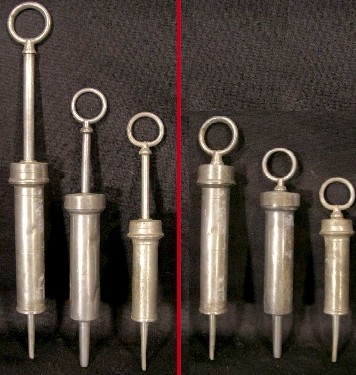
Some of the Author's Pewter Wound Syringes - Opened & Closed
Manufacturing techniques made it all but impossible to create needles fine enough to allow through skin injections. Instead, syringes at this time were simple instruments the smallest of which that I have seen had a tip that was at about an 1/8" of an inch in diameter. Their primary function was to inject fluids into or withdraw fluids from existing incisions in the skin. In the case of gunshot wounds, they were used to forcibly inject medicines deeply into the wound.
In his discussion of gunshot wounds, Ambroise Paré suggests that "if the Wound be sinuous and deep, that so the medicin cannot by that means arrive at the bottom and all the parts thereof, you must do you business by injections"1. Paré elsewhere explains that the surgeon "may make injection with a syringe, that so it may penetrate the more powerfully"2.
Richard Wiseman suggests that either pledgits dipped in medicine or injections can be used to get medicine to the bottom of a deep wound. However, he cautions "in the use of Injections be sure you do not stop the Orifice to keep the Liquor in; for so you shall distend the Ulcer, and make it more Sinuous [create more branching passageways in the body]."3
1 Ambroise Paré, The Workes of that Famous Chirurgion Ambrose Parey, 1649, p. 319; 2 Paré, 3 Richard Wiseman, Several Chirurgicall Treatises, 1686, p. 415
Step 2F: Keep Bullet and Splinter Wounds Open - Dressing
While a wound was kept open for suppuration and deep tissue healing, dressings had to be applied in order to protect it. Ambroise Paré said, "Neither must you have less care, of binding up and rolling the part, than of your medicins; for it doth not a little conduce to the cure, to bind it so fitly up as it may be without pain."1.
_Pietro_Longhi_1740.jpg)
Artist: Pietro Longhi - Making Polenta From Barley Meal (1740)
Part of wound dressing could include the application of a cataplasm, sometimes also called a poultice. In its simplest form, a cataplasm is a soft, moist mass of plant-based material which is placed on a wound. French physician Jean de Renou explains that they can be made "of Roots, Herbs,
Meal [such as bean meal, barley meal and wheat meal],
Oil and Butter; and very often, and that successfully, by clinical women, of Milk, Bread crums, Oil, and the yolks of Eggs, to mitigate [ease pain], leniate [soften the skin, particularly edges of a wound here], and concoct [digest or form new flesh]."2 Cataplasms were often combined with various medicines and created to meet the needs of the particular wound.
Sea surgeon John Atkins mentions an easy-to-procure cataplasm on a ship, given the standard naval diet.
[Cataplasms are] the proper Means to be taken [in gunshot wounds, it being in] no way inconvenient in the Navy, where a Copper-Full of Oatmeal is boiled three Times a Week, (as good for use as any,) and may be made more serviceable by adding Wine or Brandy to your Water in boiling, and at the Conclusion throwing in a little U. Dialth [unguent of marsh mallow], or other Emollient [softening medicine].3
Bandages made up the bulk of a wound dressing for bullet and large splinter wounds. In preparing for battle, sea surgeon John Woodall recommended that the surgeon have "good ligature of all sorts... tents, splints, dorsells [dossils], spunge, clowts [pieces of cloth], rowlers [roller bandages], [cloth] tape, tow, lint, plasters ready spread, and the like"4
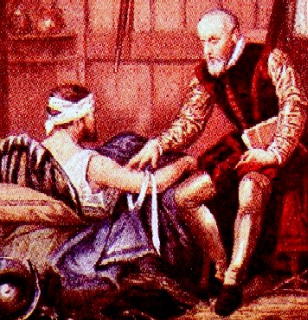
Artist: Eduoard Hamman
Ambroise Paré Bandaging an Arm Wound
Richard Wiseman noted how important the dressing was, explaining that when gunshot wounds "were rationally drest, they would digest and heal as easily as any complicated Wound."5 Sea surgeon John Moyle explained that after bolsters or compresses were applied to the part, the surgeon was to "make decent rouling"6 around the wound to keep the dressings in place. Wiseman agreed. "Let your Bandage be put on equally and gently, to retain your Dressings, and hinder the influx of Humours."7
Paré provided a very detailed schedule for bandaging gunshot and splinter wounds which ties into many of the previous wound care procedures.
The Wound at the beginning of the cure, must be dressed but once in 24 houres, that is, until the Wound come to suppuration; but when the quitture [pus] begins to flow from it, and consequently the pain and feaver are increased, it shall be drest twice a day, that is, every twelve houres. And when the quitture flowes more abundantly than unsuall, so that the collection thereof is very troublesome to the Patient, it will be requisite to dresse it every 8 houres; that is, thrice a day. Now when as this abundant efflux is somewhat slaked, and begins to decrease, it will suffice to dresse it twice a day. But when the ulcer is filled with flesh, and consequently casts forth but little matter, it will serve to dresse it once a day, as you did at the first.8
He also gives several other pointers on the best way to bandage such wounds.
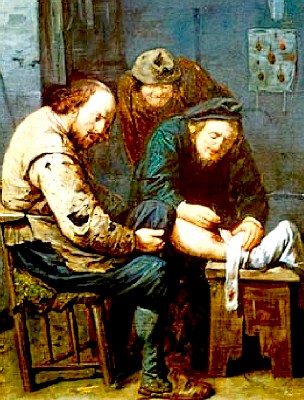
Artist: David Ryckaert
Surgeon Bandaging a Leg Wound (1638)
"All the boulsters and rowlers, which shall be applied to these kinds of Wounds, shall be dipped in Oxycrate [vinegar and water] or red wine, so to strengthen the part, and hinder defluxion."9 He also warns against making the bandages too tight so as not to cause unnecessary complications. The complications he lists that can occur include "pain, hindering the passage forth of the putredinous [stinking] vapours and excrements, which the contused flesh casts forth; and also fear of an Atrophia, or want of nourishment, the alimentary juices being hindered from coming to the part."10
Richard Wiseman gives a particularly detailed account of healing a gunshot wound with fracture that features several interesting details about dressing wounds left open to heal. He covered the wound using overlapping pieces of folded linen cloth which "encompassed the Arm. They were spread lightly with a little Cerote [cerate] made of axungia [pork lard] and Wax, to make them adhere where I placed them "11
In treating this wound, Wiseman tied a bandage with three heads (split into three pieces at the end) around the patient's arm (where the bullet wound was) with one had tied above and one below the wound.
Wiseman's 3 headed bandage was designed so that it
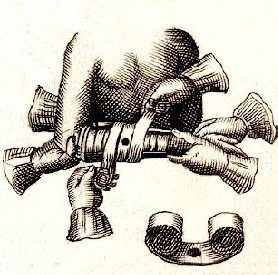
Dressing an Arm Wound With Splints, Bandaging
Above and Below, From The Chyrurgeons
Storehouse, by Johannes Scultetus, p. 68 (1653)
prest the Sanies [a thin pus mixed with serum or blood] from the neather part of the Arm to the Wound, and hindred the lapse of Matter that way. The middlemost was made to press Matter out of the Wound, and keep the Lips [of the wound] down. The uppermost served to restrain the Influx, as I said, and pressed that Matter out which was already in the Part. This Bandage was made with great moderation, and so fastened, that it might be loosened without trouble to the Patient.12
Too keep the fracture in the arm straight while it was healing, Wiseman used pasteboard splints. They were wet with vinegar (probably in part for its astringent properties). While wet, it could be formed 'close to the sides' and as it dried it "stiffened, and retained its shape, preserving the Fracture in the position I left it, and that with a very slack Bandage."13
Wiseman removed the splints and three headed bandage after 3 days.14 He regularly changed the dressings, although not as often as Paré prescribed, "purposing not to remove the two outermost heads of the main Bandage, unless it were sometime to give a little breathing to the Member. But the middle I opened as often as I thought fit, to dress the Wound."15
1 Ambroise Paré, The Workes of that Famous Chirurgion Ambrose Parey, 1649, p. 319; 2 Jean de Renou, A Medicinal Dispensatory, 1657, p. 200; 3 John Atkins, The Navy Surgeon, 1742, p. 149-50; 4,5 John Woodall, the surgions mate, 1617, p. 142; 6 Richard Wiseman, Several Chirurgicall Treatises, 1686, p. 408; 7 John Moyle, Chirugius Marinus: Or, The Sea Chirurgeon, 1693, p. 75; 8 Wiseman, p. 414; 9 Paré, p. 319; 10,11 Paré, p. 320; 12 Wiseman, p. 426; 13,14,15 Wiseman, p. 427
Step 4: Maintain Wound Temperament
As with simple wounds, maintaining the wound temperament was considered important to proper healing of gunshot and large splinter wounds. In fact, many of the suggestions found in the simple wounds article concerning wound temperament apply here. The concept of wound temperament at this time was intricately tied into humorism - the notion that the health of the body was controlled by four viscosities - blood, phlegm, black and yellow bile. There was a great deal of theory surrounding the way humors operated, 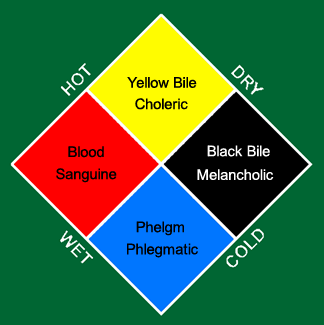
The Four Humors and Temperaments
some of which has already been touched on in the discussion of encouraging the formation of pus in these wounds.
While curing gunshot and large splinter wounds, many of the period surgical authors mention keeping unwanted humors from reaching the wound. Ambroise Paré ties humorism in to his rationale for the darkened, contused edges of these wounds. He felt this was caused by the loss of the heat near the wound site which resulted in it being discolored.
A great abundance of humors flow from the whole body, and fall down upon the affected parts, which the native heat thereof being diminished, forsakes, and presently an unnaturall heat sieses upon it. Hither also tend an universall or particular repletion [filling] of ill humors, chiefly if the Wounds possess the nervous parts as the joints.1
Combined with his notion that blood could be corrupted into other humors at the wound site2, this gathering of humors, particularly blood, was thought to be something best avoided. A variety of methods for removing or balancing the humors were proposed to combat the problem, including blood-letting, purging the digestive tract and sweating. It also lead to some more indirect humor-focused treatments including rubbing or friction and modifying the patient's diet.
1 Ambroise Paré, The Workes of that Famous Chirurgion Ambrose Parey, 1649, p. 315; 2 Paré, p. 11
Step 4: Maintain Wound Temperament - Blood-Letting
The most direct method for altering the patient's blood humors was simply to let the patient blood, by cutting open a vein and collecting the blood. Combined with the observation that bullet and large splinter wounds did not bleed very much, surgeons were often keen to bleed the patient so as to remove the unwanted humors at the wound site which the wound had failed to bleed out. As Paré says, "if the wound bleed 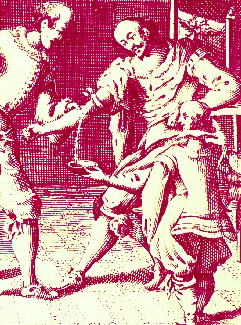
Venesection of the Arm, From Nuova et
Utlilssima Prattica, by Cintio d'Amato,
p. 41 (1671) not sufficiently at the first, you shall the next day open a vein, and take blood according to the strength and plenitude of the patient"1.
Military surgeon Richard Wiseman agrees, advising that once the patients wounds were dressed, the surgeon should "presently consider of letting him Blood, to prevent ill Accidents, and especially if he lost little or no Blood from the Wound"2. In one of his case studies, he notes that the patient "was let blood the second day"3, probably avoiding blood-letting on the day of wounding to prevent further trauma.
All of sea surgeons under study recommend bloodletting for these types of wounds. John Moyle advises 'Phlebotomy' [bloodletting] twice in his discussion of gunshot wounds4, although the second recommendation is directed specifically at patients who "incline to be Feverish". John Woodall is a little more circumspect, suggesting the surgeon should "let him bloud if neede be, and yet but a litle"5. John Atkins is more direct, stating that in the "Prosecution of Cures in Gunshot Wounds, we shall find that most of them, with the first Leisure, will require Venesection [blood-letting]... Nature [curing the wound] commencing better Efforts after a little Ventilation."6
Wiseman also recommends that when there is a plethora or an excess of blood at the wound site "Revulsion made from the same side is commended by [2nd/3rd century Greek physician] Galen."7 Revulsion was the practice of bleeding from a site distant from the wound with the idea of drawing the blood away from the wound site.
1 Ambroise Paré, The Workes of that Famous Chirurgion Ambrose Parey, 1649, p. 321; 2 Richard Wiseman, Several Chirurgicall Treatises, 1686, p. 414; 3 Wiseman, p. 427; 4 John Moyle, Chirugius Marinus: Or, The Sea Chirurgeon, 1693, p. 71 & 75; 5 John Woodall, the surgions mate, 1617, p. 141; 6 John Atkins, The Navy Surgeon, 1742, p. 149
Step 4: Maintain Wound Temperament - Purging the Digestive Tract
Purging of the patient's digestive system could be performed in two 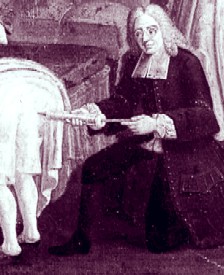
Physician Administering an Enema (1700) basic ways - either by purging up through the use of emetic medicines to cause the patient to throw up, or by purging down through the use of diuretic and laxative medicines as well as clysters (enemas).
None of the surgeons under study recommend diuretics, but one suggests the use of laxatives. Sea surgeon John Moyle insists that the surgeon treat gunshot wound victims with 'enemetics'1, another word for laxatives. He also recommends that the body of the victim be kept 'soluble' [loose and open]2, one of the ways to accomplish this was through purging.
Fellow sea surgeon John Woodall has a different take, noting "that the sicke [should] have the benefit of a naturall open body, I meane not many laxative stooles for feare of danger."3 So while Woodall is opposed to using laxatives, he still believes in purging. He goes on to recommend that the surgeon "keepe him loose onely with glisters [clysters or enemas], or suppositories"4. Sea surgeon John Atkins also recommends clysters, noting that opening the body in this manner helped the wound to heal naturally.5
Richard Wiseman likewise advises the use of 'Clysters', 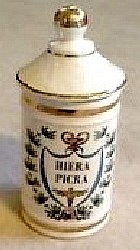
Hiera Picra
especially before performing blood-letting in patients with gunshot wounds. While he suggests enemas can be made of 'the common decoctions', he also provides recipes for some particular enemas [paragraph breaks have been added for clarity]:
[Rx] [Marsh] Mallows, Violets, Beets, Mercury, Bay and Juniper-berries, with Oil of Linseed, Honey of Roses, hiera picra, Elect. lenetiv. &c.
But if you have not these in readiness, make your Clyster with the Broth of Flesh, ol. chamomæmel. Sugar, and the Yolk of an Egge, with a little Salt, if your Broth be not salt,
or, in case of necessity, salt Water; or Broth out of the Kettle, with a few Flowers of Camomil broiled in it, and strained, adding a little Butter or Oil and red Sugar.
Any such like may serve for a good Clyster.6
1 John Moyle, Chirugius Marinus: Or, The Sea Chirurgeon, 1693, p. 71; 2 Moyle, p. 75; 3 John Woodall, the surgions mate, 1617, p. 142; 4 Woodall, p. 141; 5 John Atkins, The Navy Surgeon, 1742, p. 149; 6 Richard Wiseman, Several Chirurgicall Treatises, 1686, p. 414
Step 4: Maintain Wound Temperament - Sweating
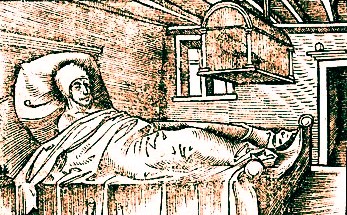
Sweating a Patient With Warm Clothes in Bed (16th c.) Sweating patients was another way to purge unwanted humors from the body - through the pores. Patients were given diaphoretic medicines which encouraged them to sweat and then often dressed in warm clothes, put into their beds with warm covers and, if available, placed in rooms where a small fire was lighted to increase the sweating. This was considered another method of 'opening the body'.
Sea surgeon John Woodall is the only surgeon under study to recommend this procedure. He advised his reader that if the patient was strong enough to endure the procedure, "you may lay him to bed to sweat, and procure him thereto by a dose of Diaphoreticon [an opium-based medicine which caused sweating] given in Trekel or Mithridate"1.
1 John Woodall, the surgions mate, 1617, p. 142
Step 4: Maintain Wound Temperament - Rubbing or Friction
Rubbing, often referred to as 'friction' could be used on or near a wounded part because the agitation was believed (among other things) to drive unwanted humors away from the wound. In one of his case studies, Ambroise Paré recommended that to dissipate the humors in the patient's skin "we ordained that he should use frictions with hot linnen clothes, and that these should be made from above downwards, from below upwards, and so on every side, and somewhat long withal: For a short friction drawes more humor into the part than it can resolve"1.
1 Ambroise Paré, The Workes of that Famous Chirurgion Ambrose Parey, 1649, p. 323
Step 4: Maintain Wound Temperament - Diet
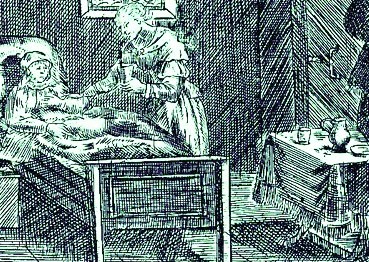
Artist: Wolf Helmhardt von Hoghburgh - Administering a Patient (1695) As with simple wounds , surgeons agreed that diet was an important part of maintaining the wound temperament for gunshot and large splinter wounds.
John Woodall rather generically advised for patients with such wounds, "Let care also bee had of his dyet, as is said, so much as the time and place can permit."1 Fellow sea surgeon John Moyle was a bit more specific, suggesting that the surgeon "keep him to the fresh Diet, and [away] from strong drink"2. Richard Wiseman suggested that patients with gunshot wounds be "kept to a spare Diet: but we allowed Wine as a Cordial to all our Patients."3
Although none of these account go into specific detail on the appropriate diet, more information can be found in Step 4 for Simple Wounds which is applicable here.
1 John Woodall, the surgions mate, 1617, p. 142;1 John Moyle, Chirugius Marinus: Or, The Sea Chirurgeon, 1693, p. 75; 2 Moyle, p. 75; 3 Richard Wiseman, Several Chirurgicall Treatises, 1686, p. 427

